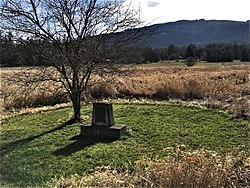Manis Mastodon site
Manis Mastodon site | |
 | |
| Nearest city | Sequim, Washington |
|---|---|
| Coordinates | 48°03′16″N 123°06′54″W / 48.05444°N 123.11500°W |
| NRHP reference No. | 78002736 [1] |
| Added to NRHP | March 21, 1978 |
The Manis Mastodon site is a 2-acre (1 ha)
History
On August 8, 1977, a farmer named Emanuel Manis was digging his property with a
In an excavated layer above the mastodon, as well as that of a 6,700-year-old deposit of ash from the eruption of Mount Mazama, a projectile-point was found in the style of Cascade points common in the area no earlier than 9,000 years ago.[11]
The site also turned up remains of caribou, bison, and plant macrofossils.
Gustafson continued to excavate at the site for eight years, finding the partial remains of two more mastodons. Though stone tools and artifacts of bone were found, Gustafson failed to find evidence of an encampment by the people theorized to have butchered the mastodons.[15]
Prior to the excavation at the Manis site, which was dated before 12,000 years ago,[16] archaeological sites west of the Cascade Range considered to be early were aged between 9,000 and 6,000 years old.[17]
During the years of excavation, Clare and Emanuel Manis welcomed over 50,000 visitors to the site. In 1978, when the site was added to the

In Oct. 2011, the Center of the Study of the First Americans (CSFA), Anthropology Department at Texas A&M University published findings from DNA tests, CT scans and radiocarbon dating on the mastodon and the spear point. The CT scan clearly established the spear point had been sharpened to a needle point by human hands. Four radiocarbon dates yielded an age of 13,860–13,763 calendar years BP.
Since the 1950s, archaeologists have believed the
In November 2011, Shirley Manis, daughter of discoverer Emanuel Manis, authored the first and only children's picture book about the Manis Mastodon site, which includes the most recent research analysis.[19]
References
- ^ "National Register Information System". National Register of Historic Places. National Park Service. January 23, 2007.
- JSTOR 41102203.
- S2CID 26346378.
- ^ Barton 2002, p. 50.
- ^ a b Barton 2002, p. 51.
- ^ a b Tom Paulson (August 9, 2002). "Still unresolved: The puzzle of the mastodon's bones". Seattle Post-Intelligencer. Retrieved February 7, 2008.
- ^ McMillan 1999, p. 104.
- ^ Sindya N. Bhanoo (October 20, 2011). "Big-Game Hunt Adds to Evidence of Early North American Settlement". New York Times. Retrieved October 11, 2011.
- ^ Bergland & Marr 1988, p. 21.
- ^ Barton 2002, p. 55.
- ^ Bergland & Marr 1988, p. 27.
- .
- ^ Bergland & Marr 1988, p. 24.
- ^ Kirk & Daugherty 1978, p. 28.
- ^ a b Kirk & Daugherty 2007, p. 11.
- ^ Kirk & Daugherty 2007, p. 10.
- ^ Kirk & Daugherty 1978, p. 82.
- ^ Meltzer 2009.
- ^ Manis 2011.
Sources
- Barton, Miles (2002). Prehistoric America: A Journey through the Ice Age and Beyond. Yale University Press. ISBN 0-30009819-7.
- Bergland, Eric O.; Marr, Jerry (1988). Prehistoric Life on the Olympic Peninsula: The First Inhabitants of Great American Wilderness. Pacific Northwest National Parks and Forests Association. ISBN 0-91401919-8.
- Daugherty, Richard D. Manis Mastodon Site (Clallam County, Washington), National Register of Historic Places Inventory-Nomination Form. National Park Service. On file at the Office of Archaeology and Historic Preservation, Olympia, Washington and at the National Park Service, Washington, DC.
- Gustafson, Carl E.; Gilbow, Delbert; Daugherty, Richard D. (1979). The Manis Mastodon Site: Early Man on the Olympic Peninsula, Canadian Journal of Archaeology, 3:157–164.
- Kirk, Ruth; Daugherty, Richard D. (1978). Exploring Washington Archaeology. University of Washington Press. ISBN 0-29595630-5.
- Kirk, Ruth; Daugherty, Richard D. (2007). Archaeology in Washington. University of Washington Press. ISBN 978-0-29598696-8.
- McMillan, Alan Daniel (1999). Since the Time of the Transformers: The Ancient Heritage of the Nuu-chah-nulth, Ditidaht, and Makah. UBC Press. ISBN 0-77480701-6.
- Manis, Shirley (2011). In a Scoop of Dirt – How Digging a Pond Changed North America's Prehistory. Shirley Manis. ISBN 978-0983928607.
- Meltzer, David J. (2009). First Peoples in a New World : Colonizing Ice Age America. Berkeley: University of California Press.

